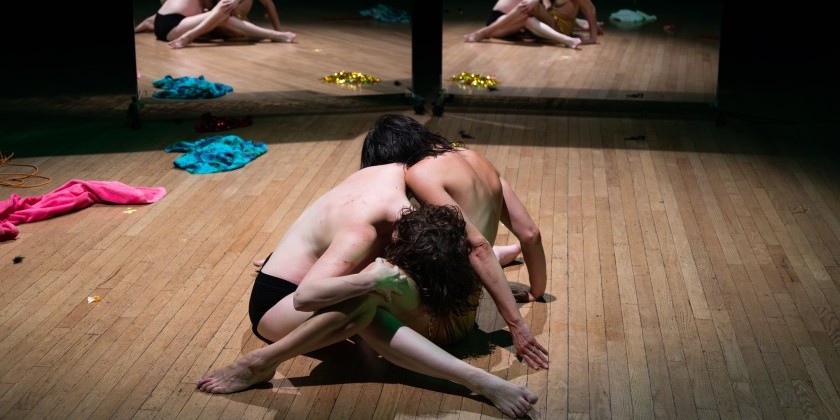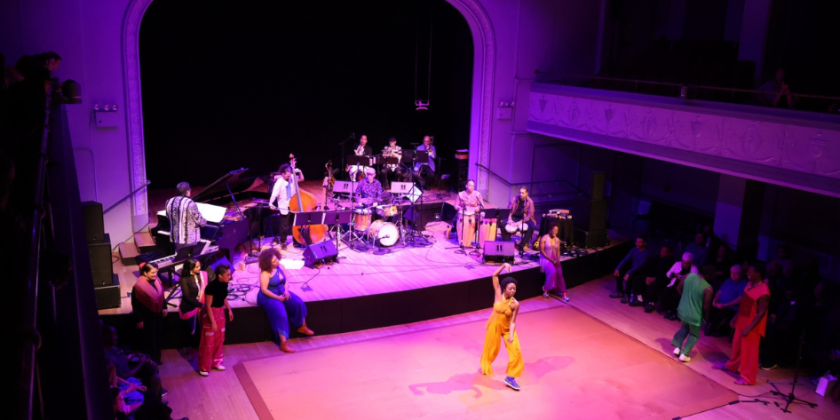IMPRESSIONS: Guillermina Quiroga Tango Company in "Tango Soirée" at Roulette

Guillermina Quiroga Tango Company with the Maurizio Najt Tango Quartet
Dancers: Guillermina Quiroga & Mariano Logiudice | Analia Carreño & Luis Ramirez | Orlando Reyes & Adriana Salgado
Musicians: Maurizio Najt, piano | Rodolfo Zanetti, bandoneón | Melisa Zohar Atoyan, violin | Tom Kirchmer, bass
Friday, March 28, 2025 at 8 PM
Roulette, 509 Atlantic Avenue, Brooklyn
Since three musicians and their respective instruments occupy the

The smallish stage might not give the three couples ample room to move to Julián Plaza’s Danzarín (from 1958), but their spatial maneuvers elegantly swishing around one another create atmosphere. Orlando Reyes and Adriana Salgado are left behind, and their nostalgic reverie to Milongueando en el 40 (by Armando Pontier) makes one long for the golden age of tango and for one’s own youth.
With the bandoneon player center stage, flanked by bass and violin, the screen behind the musicians turns gold in Comme il faut, their homage to composer and “tiger of the bandoneon” Eduardo Arolas.
Analia Carreño enters in a golden dress, with her partner, Luis Ramirez, to the sounds of Gallo ciego, a composition by pianist and violinist Agustín Bardi. Carreño and Ramirez take turns spinning or being spun on one foot. During one of these turns, she leans back into a dreamy cambré, but then ascends into a shoulder-sit from which she then spectacularly dismoun

The fabulous musicians take on Anselmo Aieta’s Palomita blanca, and give my eyes a rest. I applaud that each piece in the program so far has featured a different composer, often favoring another instrument. This thoughtfulness in programming elevates the musical accompaniment to a truly equal partner with the dance. The screen projection turns orange, and provides a welcome visual accompaniment, as Guillerma Quiroga and Mariano Logiudice take the stage to another tango by Filiberto. Quiroga in a green dress looks stunning in front of the orange background. She leans away from Logiudice as he supports her, and their oppositional force allows for long arched body lines. Off-center partnering spells technical mastery and emotional longing. A long, almost sustained slide leads into another lean-away, before Logiudice passionately dips Quiroga into a final pose. I am hooked.
José Padula’s 9 de Julio gives the orchestra melodies to shine, and the couples time to change clothes again. The three women delight in polka-dotted dresses to Plaza’s Nocturna, and by now the distinct qualities of each couple become clear. Carreño and Ramirez highlight their acrobatic abilities as he supports her in a horizontal revolution in mid-air. Such moves point to a sense of adventure, but overall the tone is playful with one couple showing the others a movement sequence and the others joyfully joining in.
.jpg)
Then the focus turns back to the musicians, and a minor visual detail stops me in my tracks. A couple of plastic water bottles on stage detract from the musicians’ dedication to their craft and the elegance of the simple black garments worn by Rodolfo Zanetti and Tom Kirchmer, and violinist Melisa Zohar Atoyan’s lovely sequined dress. I wish for a side table or two, and a water pitcher and glasses to fall in line with the beauty of the music. The prosaic plastic bottles look out of place, and destroy the illusion of time travel that the compositions suggest.
Carreño and Ramirez mean business in Astor Piazzolla’s Michelangelo ’70. He wears just a shirt with no jacket, lifts her frequently overhead, and raises her from a split on the floor. A sexy, black dress flits in time with a funny, footsy sequence, and the dress helps her seem to float when Ramirez supports her through a walk suspended in mid-air.
During Aieta’s Pavadita, the screen transforms to a starry night sky, and in the ensuing Oblivion (by Piazzolla) a beautiful blue fabric seems at first to enshroud Quiroga, but then magically moves with her. Logiudice partners Quiroga in sustained lifts that transport the audience to a dreamlike state. Magic is in the air. Her balletic extensions seem to float on clouds. I catch my jaw on the floor sometime during the next musical number, Canaro in Paris (by Juan Caldarella and Alejandro Scarpino). Then a Central Park bridge fills the screen, setting the stage for three couples who dance to Francisco Canaro’s Corazón de oro. As the women stroll in summer dresses on the arms of their respective partners, this ditty does not amount to much. A quick partner switch, and another swift change back, make me conscious of the rigid, one-on-one, male-female formula that makes the evening look old-fashioned.

Pedro Laurenz’s Milonga de mis amores highlights the dedicated musicianship of this outstanding quartet, and underscores the variety of tango composers and musical styles. Two duets to Piazzolla’s music lead to a final ensemble number by Gerardo Matos Rodriguez. In Zum, Reyes and Salgado (in a black dress with red patterns) move slowly and with reserve. Here is a mature couple; and the lifts are age-appropriate. This duet offers a healthy balance to the acrobatic prowess displayed earlier by Carreño and Ramirez.
In Libertango, Quiroga and Logiudice continue where they left off in Oblivion, except now she wears a metallic silver dress that sparkles in the colors of the rainbow. Their seamless partnering has me spellbound; yet it is a small movement of her hand, while it rests on his shoulder blade, that confirms her artistry. After momentarily relaxing the hand, she reengages it sequentially through her palm. Watching it, I feel caressed. A wonderful lift sequence, in which she rotates horizontally in front of his chest, repeats toward the end of the duet giving it a satisfying choreographic frame. The three couples reconvene to La Cumparsita, mainly to acknowledge each other, to salute the musicians, and to receive their well-deserved applause.















